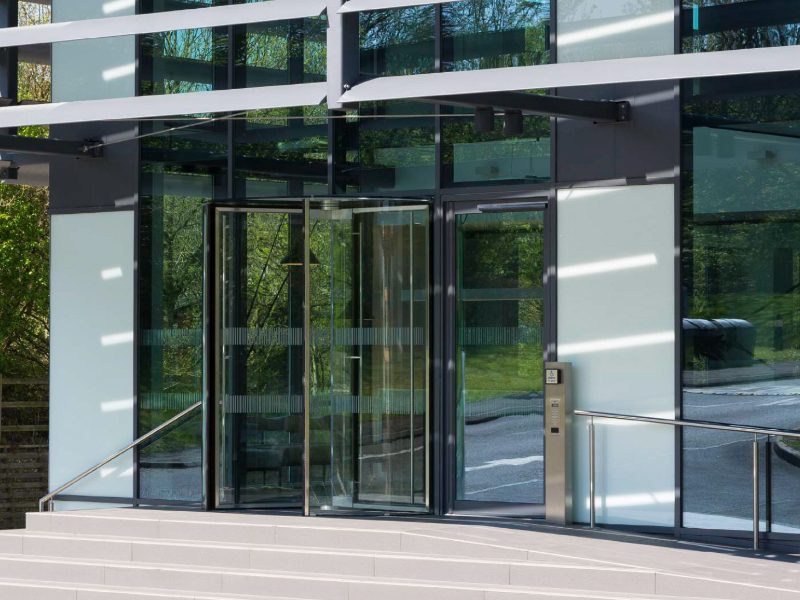Accessible building design is no longer optional. Every public entrance should support safe, easy and dignified access for all users. When it comes to revolving doors, the challenge is balancing efficiency, aesthetics and inclusive access.
In this guide, we’ll explore how revolving doors can support disabled access entry while maintaining two very important factors for businesses: energy efficiency and security.
What is a revolving door and how does it affect disability access?
A revolving door is a rotating entrance system that typically includes three or four wings. These wings move around a central axis, creating individual compartments. These clever entry solutions offer energy savings and effective climate control by minimising air exchange between the inside and outside.
To find the right revolving door for your needs, let’s take a closer look at the options. Standard revolving doors can be difficult for users with mobility aids, such as wheelchairs or walkers. That’s because tight spacing and consistent movement can create barriers for disabled access entry. Choosing the right revolving entry solution is critical to promote an inclusive and disable access-friendly environment.
Why modern revolving entry solutions must include disability access control
The best revolving doors are designed with accessibility in mind. Take automatic revolving doors that come with built-in accessibility buttons. These allow the user to slow or pause the door’s rotation, creating more time and space to enter safely.
Disability access control features, like speed adjustments and push-button opening, also make a huge difference. These elements let the door function for all users, including those with physical or cognitive impairments.
Three-wing revolving door: a smarter choice for disabled access
Door configuration matters. A three-wing revolving door generally provides more space per compartment than a four-wing model. This wider segment design is a key factor for accommodating mobility aids.
A three-wing revolving door with a minimum diameter of 2,800 mm is often recommended. At 3,400 mm or more, doors can even qualify for International Accessibility Symbol (IAS) certification. This size comfortably fits wheelchairs, scooters, and other assistive devices, making it ideal for disability access entry.
Automatic revolving vs. manual revolving for disabled access doors
Manual revolving doors require physical effort and timing, which can be a significant challenge for many users with disabilities. Automatic revolving doors offer a smoother entry experience, responding to motion or button activation alongside including safety sensors.
These doors may also feature folding wings that can temporarily create a clear path. This is especially useful in emergencies or for users who need more time to move through. These revolving doors are a much better fit for inclusive spaces that prioritise disability access control.
Designing entrances that meet disabled access entry standards
Creating an accessible entrance starts with choosing the right door system – but it’s more than just the revolving door. A compliant design often includes a secondary access point, a swing or sliding door placed adjacent to the main entrance.
Here are best practices for inclusive revolving entry solutions:
- Install an automatic revolving door with an accessibility button.
- Use a three-wing model with a large enough diameter (minimum 2,800 mm).
- Provide visual contrast on door panels and clear signage.
- Include adjacent swing or sliding doors for those who prefer them.
- Make sure thresholds are low or level to avoid tripping hazards.
In the UK, the Equality Act 2010 and Building Regulations Approved Document M require public entrances to accommodate everyone. These rules apply to both new builds and refurbishments, so it’s important to onboard the right solution.
Combining energy efficiency and disabled access entry
One reason building owners and architects love revolving doors is their energy performance. These clever solutions help maintain internal temperatures and reduce heating or cooling costs, with constant enclosure also preventing drafts and air pressure loss.
You might assume that adding disabled access entry features would reduce efficiency, but that’s not something you have to worry about. An automatic revolving door with accessibility control still retains most energy-saving benefits. In fact, auxiliary swing doors are often used only when needed, maintaining performance for the majority of traffic.
Security benefits in revolving doors for disabled access
Beyond access, security is another reason to choose a revolving entry solution. Many automatic revolving doors can be integrated with access control systems. These include card readers, biometric scanners and even facial recognition.
Advanced models also include tailgating detection and emergency stop features. These allow buildings to meet both safety and disability access needs without compromise. When combined with video monitoring and building automation, you get a secure yet accessible system.
Real-world examples of inclusive revolving door design
We offer bespoke revolving door solutions that prioritise accessibility. Our automatic revolving doors can include speed controls, folding mechanisms, and low-energy sensors to make your revolving door fit the unique requirements of your space.
Whether you’re looking for a framed revolving door or a glass revolving door, our entry solutions are built to suit high-traffic areas while offering accessibility features. You can even customise your revolving door to include emergency break-out wings and disability access buttons.
Whether in hospitals, offices, or transport hubs, combining design flexibility with access requirements creates better outcomes for everyone, leaving no one behind.
Building access that works for everyone
Revolving doors can be both stylish and inclusive, but they need to be a considered installation and designed properly. A well-configured automatic revolving door, supported by disability access control features, improves usability for all visitors. By choosing a three-wing or four-wing model with a generous diameter and an adjacent accessible door, you’ll create an entry point that is functional, compliant and welcoming.
Investing in accessible revolving entry solutions isn’t just good design, it’s good business. It shows a commitment to equality, safety and long-term sustainability.
If you want to chat to us about your entry solution or to find out more about disabled access-friendly revolving doors, reach out to our team.





















